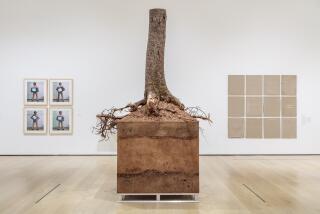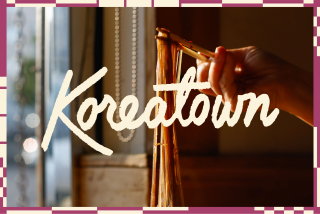<i> Namsadang</i> : The People’s Choice in Korea
- Share via
Unblushingly earthy and blunt, performances of the itinerant Korean troupes known as namsadang began 5,000 years ago as a safety valve for the urges and opinions of ordinary people in a highly structured society. Preserved as a living tradition by Namsadang, a 10-member troupe from Seoul, this irreverent popular entertainment comes to Japan America Theatre tonight .
The centerpieces of each performance are satirical plays enacted by masked dancers or puppets. Under the harmless guise of an evening’s frolic, Buddhist monks cavort with their girlfriends, Western visitors display their greed and husbands and wives utterly disregard the rules of marriage. Characters frequently smack and sniff at each other; at other moments they gleefully pantomime such activities as sex, vomiting and urination.
To leaven Namsadang’s knockabout farce, interludes of drum and gong music provided by Samul-Nori--a quartet of percussion players--add a cheery air. As they play, the musicians step out in martial formations or rotate their heads to send the paper ribbons on their hats whirling through the air.
Sitting in a Cosa Mesa restaurant at the beginning of Namsadang’s cross-country tour, Samul-Nori’s bearded 36-year-old leader Kim Duk Soo reserved his English for exclaiming over the spicy fish and garlic bread, reminders of the pungent cuisine of his homeland. Responding to questions, he directed long, impassioned torrents of Korean to Susanna Samstag, the company’s American-born manager.
A virtuoso changgo (hourglass-shaped drum) player, Kim was steeped in the namsadang tradition by his performer father. But he is also keenly interested in jazz and rock ‘n’ roll, and believes in what he calls “new tradition,” a flexible approach to a traditional style. Actually, that’s exactly what namsadang --currently performed in a style that dates back only to the early 20th Century--has always been about.
Unlike the codified, formalized rituals of court dance, the people’s performances changed all the time, depending on the individual abilities of the musicians and dancers, local cultural influences absorbed during their wanderings and the particular issues that seemed likely targets for satire.
Certain movements of the dancers derive from daily activities--like squatting down to eat--that may someday seem impossibly quaint to increasingly Westernized Koreans. But other elements of namsadang-- the pulse of the dancers’ movements, the types of musical instruments, the witticisms in the plays--are embedded in elemental aspects of Korean culture.
An essential Korean belief is that every whole has three parts, mirroring a world in which the human being lives between sky and earth. That dictum colors even the tiniest motion of a dancer or musician.
“When you learn a dance step, you don’t start with a flat foot and step out,” Samstag said. “You take a breath and then you go into the step and then there’s a rebound.”
Curved lines are prized above straight lines, so the dancers’ bodies are never fully extended and arms and shoulders are rounded. Even a musician’s hand hitting a drum describes a curved path rather than moving up and down.
The instruments themselves are believed to have direct parallels in the sounds of nature. The changgo makes a sound akin to falling rain, the sharp-sounding small gong represents lightning, the large gong suggests the sound of the wind and the big barrel drum delivers the boom of thunder.
The pun-filled dialogue the puppets speak--”hysterically funny,” according to Samstag--has much to do with quirks of the Korean language. For American audiences, the troupe was obliged to cut down “a lot” on the dialogue, she said. “The puppets are going to do more acting than they normally would and more dancing and singing.
“(On the tour) I’m going to be listening to what people say in the audience to see how much people get out of it. Depending on the reaction, we’ll add more (dialogue) or take away. But at the (Seoul) Olympic Arts Festival, people from other countries loved it. It’s immediately funny!”
More to Read
The biggest entertainment stories
Get our big stories about Hollywood, film, television, music, arts, culture and more right in your inbox as soon as they publish.
You may occasionally receive promotional content from the Los Angeles Times.










